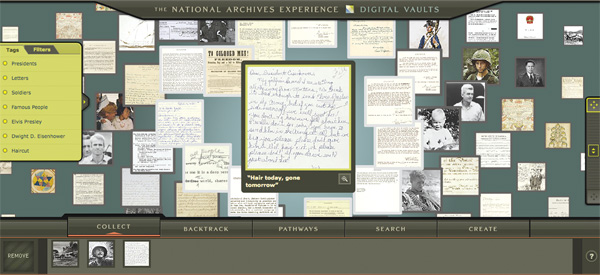
I vividly remember being disappointed during my first year of teaching: my students weren’t nearly as excited about primary source documents as I was. Primary source documents, as you know, offer readers a unique, real-world perspective, and I thought my kids would love delving into them. I soon learned that my disappointing results weren’t due to the documents that I’d selected, but rather how I was having students use them. That first year, they weren’t doing anything but reading them. Today, Web-based tools enable students to discover more primary sources than ever before and engage them in dynamic ways. The following items are some of my favorites.
The U.S. National Archives Experience Digital Vaults (pictured above) offers students a good introduction to discovering and working with primary source materials. Rather than turning kids loose on millions of records in the National Archives, Digital Vaults focuses on a curated collection of 1,200 items. Within the site, there are activities designed to help students discover important connections between primary sources. One section, Pathways Challenges, provides quizzes that ask kids to analyze a specific resource and then find the related document within the collection. Teachers and students can create their own quizzes or take advantage of the premade challenges. Students who create free Digital Vaults accounts can collect primary source documents and images and use them to create digital posters and videos within the available templates.
A related resource, National Archives Docs Teach offers seven free tools that educators can use to create interactive learning activities based on any primary source in the National Archives. The seven tools are: Finding a Sequence; Focusing on Details; Making Connections; Mapping History; Seeing the Big Picture; Weighing the Evidence, and Interpreting Data. To get a sense of how each of these works, you can view activities that teachers have created and shared.
Historical Scene Investigation, hosted by the University of William & Mary School of Education, provides a good model for primary source-based classroom activities, presenting historical cases for students to crack. Each case presents kids with clues to analyze in order to form a conclusion to each investigation. The clues come in the form of primary documents and images and include secondary sources. HSI provides students with “case files” in which they can record the evidence they find in the historical content. At the conclusion of their inquiries, kids must answer questions and decide if the case should be closed or if more sleuthing is necessary. If the premade activities don’t fit your curriculum, use the model to create your own historical scene investigations with your own resources.
The World Digital Library is a database of more than 7,000 primary source documents and images from around the world. Sponsored by the United Nations Educational, Scientific and Cultural Organization, WDL can be searched by date, era, country, continent, topic, and type of resource. Search tools and content descriptions are available in seven languages. And roughly half of WDL’s resources, in my estimation, consist of historical maps and images. Students can also search the database by clicking through the map on its homepage. Use the Historical Scene Investigation or Pathways Challenge model to develop activities for your students to complete when they visit the World Digital Library.
How about your students? If they’re not wild about primary sources, then try using these tools to get them to interact with the documents—instead of just passively reading them. You ust might be able to change their attitudes for the better.


